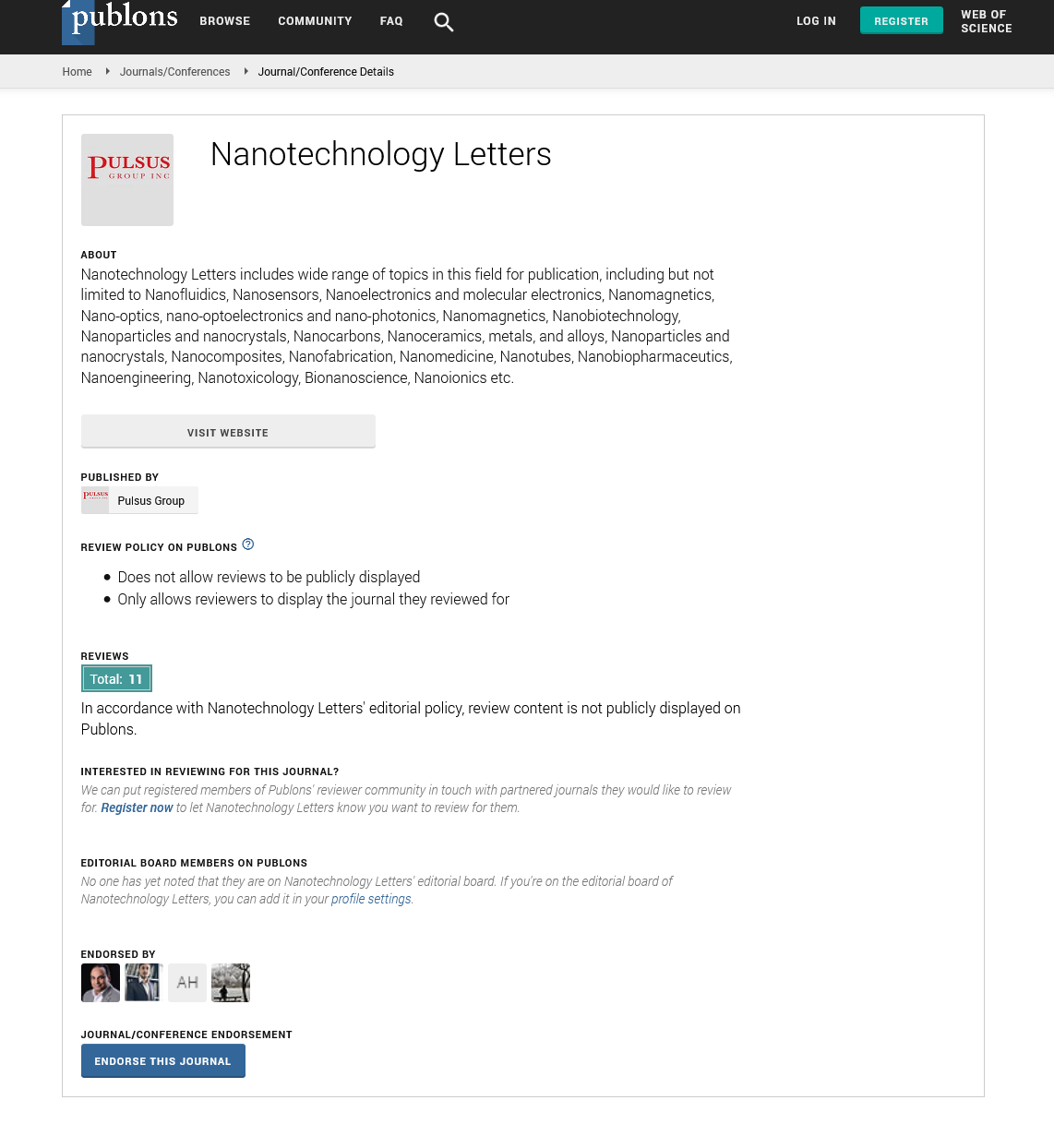Nanomedicine: A Brief Note
Received: 07-Sep-2022, Manuscript No. PULNL-22-5610; Editor assigned: 09-Sep-2022, Pre QC No. PULNL-22-5610 (PQ); Accepted Date: Sep 27, 2022; Reviewed: 12-Sep-2022 QC No. PULNL-22-5610 (Q); Revised: 15-Sep-2022, Manuscript No. PULNL-22-5610 (R); Published: 28-Sep-2022, DOI: 10.37532. pulnl.22.7 (5).20-21
Citation: Pharasi D. Nanomedicine: A brief note. Nanotechnol. lett.; 7(5),20-21
This open-access article is distributed under the terms of the Creative Commons Attribution Non-Commercial License (CC BY-NC) (http://creativecommons.org/licenses/by-nc/4.0/), which permits reuse, distribution and reproduction of the article, provided that the original work is properly cited and the reuse is restricted to noncommercial purposes. For commercial reuse, contact reprints@pulsus.com
Abstract
Nanomedicine is a discipline of medicine that uses nanotechnology knowledge and techniques to prevent and treat disease. Nanomedicine is the use of nanoscale materials, such as biocompatible nanoparticles and nanorobots, in a living body for diagnosis, delivery, sensing, or actuation. This opinion article aims to provide a brief overview about nanomedicine, it’s applications in drug delivery and development of analytical tools
Key Words
Nanomedicine ; Drug delivery; Diagnosis
Description
Nanomedicine is a pharmacological class that applies nanotechnology knowledge and capabilities to illness prevention and treatment. In fact, the modern pioneers of nanomedicine are Metchnikov and Ehrlich, who received the Nobel Prize in Medicine in 1908. Cell-specific diagnosis and treatment Nanomedicine is the use of biocompatible nanoparticles, such as nanorobots and nanoscale materials, in a living organism for diagnosis, delivery, sensing, or actuation.
Actually, nanomedicine is the application of nanotechnology for medical reasons, and it is described as the use of nanoparticles for illness diagnosis, monitoring, control, prevention, and treatment. Furthermore, the >400 nanomedicine formulations currently in clinical trials are expected to bring novel clinical solutions to the market, such as platforms for macromolecule delivery, either alone or in combination with other key enabling technologies such as biotechnologies, advanced materials, biomaterials, and microfluidics. When compared to conventional medicines, nanomedicine has improved efficacy, bioavailability, targeting ability, dose-response, personalization, and safety
The ultimate goal of nanomedicine is to be able to resist tailored delivery of complex assemblies containing enough therapeutic and diagnostic components for highly localised drug release with no harmful side effects and reliable detection of site-specific therapeutic response. The National Institute of Health is currently evaluating several safety issues in the United States, including particle pathways in the human body; the length of time nanoparticles remain in the body; the consequences on cellular and tissue functions; access to circulation through dermal exposure; and unexpected in vivo reactions. Doxil was the first cancer nanomedicine approved by the US Food and Drug Administration. It has been used to treat adult cancers including as ovarian cancer, multiple myeloma, and Kaposi'ssarcoma, a rare malignancy that frequently affects patients with immunological deficiencies such as HIV and AIDS, since 1995. Doxil was the first nanomedicine medicine. Doxil, a circulating sustainedrelease liposomal Nano formulation of doxorubicin, was one of the first nanomedicines approved by the FDA in 1995. It was initially approved to treat AIDS-related Kaposi's sarcoma, and then for refractory ovarian cancer and multiple myeloma. Scientists are increasingly interested in the future of nanomedicine for various medical uses. These include more effective drug delivery and targeting, as well as personalised nanomedicine, in which a drug is administered to a patient based on their genetic profile
Applications of nanomedicine
Nanomedicine is holding changes in clinical practice by the introduction of novel medicines for both diagnosis and treatment, having enabled to address unmet medical needs, by integrating effective molecules that otherwise couldn't be used due to their high toxicity for instance impact ,exploiting multiple mechanisms of action for instance Nanomag, multifunctional gels, maximizing efficacy for instance by increasing bioavailability and reducing dose and toxicity, providing drug targeting, controlled and site specific release, favouring a preferential distribution within the body for example in areas with cancer lesions and improved transport across biological barriers.Nanomedicine comprises both biological and non-biological medical products. The biological nanomedicines are obtained from biological sources, while non-biological are mentioned as non-biological complex drugs, where the active principle consists of different synthetic structures. In the last decades, we have assisted to the translation of several applications of nanomedicine in the clinical practice, ranging from medical devices to Nano pharmaceuticals. However, there is still a long way toward the complete regulation of nanomedicines, from the creation of harmonized definitions in all Europe to the development of protocols for the characterization, evaluation and process control of nanomedicines. A universally accepted definition for nanomedicines still doesn't exist, and should even not be feasible in the least or useful. The medicinal products span an outsized home in terms of type and structure, and are utilized in a mess of indications for acute and chronic diseases.
Analytical and diagnostic instruments
Because of the limitations of existing diagnostic technologies, some diseases can only be discovered at a late stage. Nanodiagnostics, defined as the application of nanotechnology to clinical diagnostics was created to fulfil the desire for greater sensitivity in clinical diagnosis and earlier disease identification. Micro and nanobiotechnology applications in medical diagnostics can be split into two broad categories: in vitro diagnostic devices and in vivo imaging.
Drug delivery
Nanovehicles, nanoscale compounds used as a therapeutic tool and designed to specifically accumulate in the sites of the body where they are needed to improve pharmacotherapeutic outcomes, have been one of the most important nanotechnology applications developed over the last decade. The primary goal of this application is to improve therapeutic efficacy while reducing toxicity. As a result, nanodrugs and nanodiagnostics have been developed to improve bioavailability profiles, allowing lower doses to be administered while minimising adverse reactions seen with conventional drugs in clinical practise and improving patient health.
There are numerous therapeutic applications based on nanotechnologies in the field of cancer therapy, with a significant advancement in drug delivery systems. The prospect of improving drug efficacy through biological targeting of drugs in current clinical use is driving the rise in nanotechnology applications in medicine Nanoparticles are typically administered intravenously in cancer treatments, travelling through the bloodstream and passing through biological barriers (cell membranes) of the organism to reach and activate their molecular targets. One of the primary goals of nanotechnology is to overcome the shortcomings of traditional chemotherapy, such as the numerous drug resistance mechanisms that render this treatment ineffective in a large percentage of cancer cases.
Nanoparticles can overcome the side effects of conventional therapies by: (1) sustaining drug release over time; (2) passive enhanced permeability, which targets the effect to tumour tissue; (3) targeting the cell surface with endosomal uptake and membrane disruption ligands; (4) allowing drug release in the cell cytoplasm; and (5) protecting the drug from enzymatic degradation.The primary goals of drug delivery design are as follows: (i) to reduce the side effects of conventional therapy by decreasing drug concentration in normal tissues; (ii) to improve the pharmacokinetics and pharmacodynamic profiles; (iii) to allow intravenous drug administration by increasing drug solubility; and (iv) to minimise drug loss in transit while maximising drug concentration in the tumor.
Micelles: A micelle is an assemblage of amphiphilic surfactant molecules that form spherical vesicles when immersed in water. They have a hydrophobic core through which hydrophobic chemicals, such as pharmaceutical drugs, can be injected for release in various areas of the organism. A micelle is typically made up of a hydrophilic or polar charged head group and a hydrophobic tail, which is typically made up of a hydrocarbonated portion of long fatty acids. The size of the micelle is determined by the properties of the surfactants that comprise it
Solid nanoparticles: This structure has several distinguishing characteristics, including: (a) the material present in the particle's centre forms a solid core at least at room temperature; and (b) solid nanoparticles that are not necessarily spherical. The geometry might shift, revealing angular structures. This property is especially noticeable if the nanoparticle is made up of protein crystals or another medicinal substance. A surfactant is frequently required to stabilise the nanoparticle in order to avoid flocculation.
Dendrimers: These are typically three-dimensional structures with a treelike shape and a molecule as the centre core. Branching units are polymerized from the core molecule or generated from the periphery and terminate at the central molecule. Branch lengths are constrained by steric constraints, and dendrimer forms are sphere-shaped, with a small molecular size but a large molecular weight. These structures transport drugs in two ways: (a) by attaching drug molecules to functional groups on the dendrimer surface; and (b) by enclosing the drugs in dendritic channels within the sphere.






